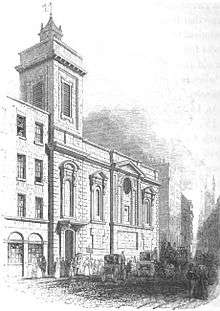St Mildred, Poultry
Coordinates: 51°30′49″N 0°5′24″W / 51.51361°N 0.09000°W
| St. Mildred, Poultry | |
|---|---|
 St. Mildred, Poultry in the 1820s | |
| Country | United Kingdom |
| Denomination | Church of England |
St Mildred, Poultry was a parish church in the Cheap ward,[1] of the City of London.[2] It was rebuilt after the Great Fire of London and demolished in 1872. St Mildred in the Poultry was the burial place of the writer Thomas Tusser. Some description of the church and its monuments is given in John Stow's Survey of London.[3]
History
Medieval building
The church stood the north side of Poultry at its junction with Mansion House Street. The first church can be traced back to 1175, in the reign of Henry the Second;[4] by 1456, it had fallen into disrepair, and had to be taken down and rebuilt.[5]
Rebuilding after the Great Fire
The medieval building was destroyed in the Great Fire of London in 1666, and a new church was completed in 1676 to the designs of Sir Christopher Wren, after which the parish was united with that of St Mary Colechurch, which was not rebuilt. George Godwin described the interior of the new church as "a simple room with a flat ceiling coved at the sides … remarkable for nothing but a strange want of symmetry apparent at the west end". It was 56 feet long, 42 feet wide and 36 feet high.[5] The most ornamented part of the exterior was the south side, towards Poultry, with a central pediment and Ionic pilasters.[6] There was a 75 foot high tower,[5] topped by a copper weather-vane in the form of a ship.[6]
An organ was provided in the mid eighteenth century by George England.
Demolition
The building was sold for £50,200 in 1871 under the Union of Benefices Act[6][7] and demolished the following year.[8] A City Corporation Plaque now marks the site. The parish was united with that of St Olave Old Jewry and the proceeds of the sale were used to build and endow the new church of St Paul, Goswell Road, which also received the City church's pulpit and woodwork. The weather vane was transferred to St Olave Old Jewry.[6] When the parish of St Olave also ceased to be viable, the combined parishes were in turn united with St Margaret Lothbury.[9]
Rectors (incomplete list)
- 1523-1527 John Smith[10]
- 1541 John Weale[11]
- 1590-1617 Thomas Sorocold[12]
- 1618-1638 Nathaniel Shute[13][14]
- 1638, ejected Richard Maden[15]
- 1645-6 Henry Scudder as minister[16]
- 1661-1673 Richard Perrinchief, Archdeacon of Huntingdon[17]
- 1673-1696 John Williams[18][19]
- 1726-1748 William Wallis[20]
- 1748-1775 Benjamin (John) Newcombe, Dean of Rochester[21][22]
- 1775-1806 Robert Bromley[23]
See also
- List of Christopher Wren churches in London
- List of churches rebuilt after the Great Fire but since demolished
References
- ↑ The mediaeval meaning of the word is market “Oxford English Dictionary Vol 2” p634 Murray, J(Ed): OUP, Oxford,1893
- ↑ “Churches of the City of London” Reynolds, H: Bodley Head, London, 1922
- ↑ W. J. Thoms (ed.), A Survey of London written in the year 1598, by John Stow (based on 1798 edition), (Chatto and Windus, London 1876), pp. 98-99.
- ↑ “Vanished churches of the City of London”, Huelin, G: Guildhall Library Publishing, London 1996 ISBN 0-900422-42-4
- 1 2 3 Godwin, George; John Britton (1839). The Churches of London: A History and Description of the Ecclesiastical Edifices of the Metropolis. London: C. Tilt.
- 1 2 3 4 Wheatley, Henry Benjamin; Cunningham, Peter (2011) [1891]. London Past and Present: Its History, Associations, and Traditions. Cambridge: Cambridge University Press. p. 640. ISBN 978-1-108-02807-3. Retrieved 24 September 2011.
- ↑ “History of the church of St Mildred the Virgin in Poultry in the City of London”: John Russell Smith,London,1872
- ↑ "The London Encyclopaedia" Hibbert,C;Weinreb,D;Keay,J: London, Pan Macmillan, 1983 (rev 1993,2008) ISBN 978-1-4050-4924-5
- ↑ Papers relating to the proposed union of the rectory of St Margaret Lothbury MS 08905 cited in “City of London Parish Registers Guide 4” Hallows,A.(Ed) - London, Guildhall Library Research, 1974 ISBN 0-900422-30-0.
- ↑ "Smith, John (SMT511J)". A Cambridge Alumni Database. University of Cambridge.
- ↑ "Weale, John (WL554J)". A Cambridge Alumni Database. University of Cambridge.
- ↑ Dictionary of National Biography
- ↑
 "Shute, Christopher". Dictionary of National Biography. London: Smith, Elder & Co. 1885–1900.
"Shute, Christopher". Dictionary of National Biography. London: Smith, Elder & Co. 1885–1900. - ↑ "Shute, Nathaniel (SHT603N)". A Cambridge Alumni Database. University of Cambridge.
- ↑ "Maden, Richard (MDN611R)". A Cambridge Alumni Database. University of Cambridge.
- ↑
 "Scudder, Henry". Dictionary of National Biography. London: Smith, Elder & Co. 1885–1900.
"Scudder, Henry". Dictionary of National Biography. London: Smith, Elder & Co. 1885–1900. - ↑ "Perrinchief, Richard (PRNF637R)". A Cambridge Alumni Database. University of Cambridge.
- ↑ "Williams, John (WLMS660J)". A Cambridge Alumni Database. University of Cambridge.
- ↑
 "Williams, John (1636?-1709)". Dictionary of National Biography. London: Smith, Elder & Co. 1885–1900.
"Williams, John (1636?-1709)". Dictionary of National Biography. London: Smith, Elder & Co. 1885–1900. - ↑ "Wallis, William (WLS682W)". A Cambridge Alumni Database. University of Cambridge.
- ↑ "Newcombe, Benjamin (NWCM734B)". A Cambridge Alumni Database. University of Cambridge.
- ↑ http://www.british-history.ac.uk/report.aspx?compid=62910
- ↑ "Bromley, Robert (BRMY769RAZ)". A Cambridge Alumni Database. University of Cambridge.
External links
Explanation of dedicationVictorian Etching of church